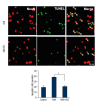Induced neural stem cells protect neuronal cells against apoptosis
- PMID: 25554259
- PMCID: PMC4280057
- DOI: 10.12659/MSM.891343
Induced neural stem cells protect neuronal cells against apoptosis
Abstract
Background: Neuronal cells are vulnerable to many stresses that can cause apoptosis. Reprogramming of fibroblasts into induced neural stem cells (iNSCs) is a potentially unlimited source of neurons. Discovering agents that can provide neuronal protection against these apoptotic stimuli is important for developing therapeutic strategies for various brain diseases.
Material and methods: We investigated the therapeutic effects of iNSCs against apoptosis activator II (AAII)-induced apoptosis of cortical neuronal cells. Apoptosis was confirmed by double immunocytochemistry with NeuN and 4',6-diamidino-2-phenylindole using terminal deoxynucleotidyl transferase-mediated digoxigenin-dUTP-biotin nick-end labeling. We performed Western blot analyses for activated caspase-3, Bcl-2, phosphorylated Akt, and phosphorylated extracellular signal-regulated protein kinase (ERK). The level of vascular endothelial growth factor (VEGF) was analyzed using enzyme-linked immunosorbent assays (P<0.05).
Results: Cortical neuronal cells cultured with iNSCs had fewer apoptotic cells than those cultured without iNSCs. We found that cells cultured with iNSCs had a significantly lower caspase-3 level and a significantly higher Bcl-2 level than cells cultured without iNSCs. Cells cultured with iNSCs had higher VEGF levels than cells cultured without iNSCs. The levels of phosphorylated Akt and phosphorylated ERK were significantly higher in cells cultured with iNSCs than in cells cultured without iNSCs.
Conclusions: Our findings suggest that iNSCs activate Akt and ERK, which are associated with the inhibition of neuronal apoptosis. Thus, treatment with iNSCs may help reduce neuronal loss in brain disease. Further studies aimed at proving this hypothesis might help establish therapeutic agents that can prevent neuronal cell death and help cure neurodegenerative diseases.
Figures








Similar articles
-
Assessment of the level of apoptosis in differentiated pseudo-neuronal cells derived from neural stem cells under the influence of various inducers.Am J Stem Cells. 2024 Dec 15;13(6):250-270. doi: 10.62347/BPTG6174. eCollection 2024. Am J Stem Cells. 2024. PMID: 39850017 Free PMC article. Review.
-
Induced neural stem cells have protective effects on cortical neuronal cells in vitro.Neurol Sci. 2015 Apr;36(4):527-34. doi: 10.1007/s10072-014-2012-1. Epub 2014 Nov 20. Neurol Sci. 2015. PMID: 25410028
-
iNSC suppress macrophage-induced inflammation by repressing COX-2.In Vitro Cell Dev Biol Anim. 2015 Feb;51(2):157-64. doi: 10.1007/s11626-014-9816-4. Epub 2014 Sep 24. In Vitro Cell Dev Biol Anim. 2015. PMID: 25248435
-
PI3K/Akt signaling pathway is required for neuroprotection of thalidomide on hypoxic-ischemic cortical neurons in vitro.Brain Res. 2010 Oct 21;1357:157-65. doi: 10.1016/j.brainres.2010.08.007. Epub 2010 Aug 10. Brain Res. 2010. PMID: 20705061
-
Induced neural stem cells (iNSCs) in neurodegenerative diseases.J Neural Transm (Vienna). 2013 Sep;120 Suppl 1:S19-25. doi: 10.1007/s00702-013-1042-9. Epub 2013 May 30. J Neural Transm (Vienna). 2013. PMID: 23720190 Review.
Cited by
-
Combination cell therapy with mesenchymal stem cells and neural stem cells for brain stroke in rats.Int J Stem Cells. 2015 May;8(1):99-105. doi: 10.15283/ijsc.2015.8.1.99. Int J Stem Cells. 2015. PMID: 26019759 Free PMC article.
-
Calenduloside E alleviates cerebral ischemia/reperfusion injury by preserving mitochondrial function.J Mol Histol. 2022 Aug;53(4):713-727. doi: 10.1007/s10735-022-10087-5. Epub 2022 Jul 12. J Mol Histol. 2022. PMID: 35819738 Free PMC article.
-
Protective Effects of Propolis Extract in a Rat Model of Traumatic Brain Injury via Hsp70 Induction.Open Access Maced J Med Sci. 2019 Aug 30;7(17):2763-2766. doi: 10.3889/oamjms.2019.736. eCollection 2019 Sep 15. Open Access Maced J Med Sci. 2019. PMID: 31844433 Free PMC article.
-
Assessment of the level of apoptosis in differentiated pseudo-neuronal cells derived from neural stem cells under the influence of various inducers.Am J Stem Cells. 2024 Dec 15;13(6):250-270. doi: 10.62347/BPTG6174. eCollection 2024. Am J Stem Cells. 2024. PMID: 39850017 Free PMC article. Review.
-
Desoxyrhapontigenin attenuates neuronal apoptosis in an isoflurane-induced neuronal injury model by modulating the TLR-4/cyclin B1/Sirt-1 pathway.AMB Express. 2020 Sep 30;10(1):175. doi: 10.1186/s13568-020-01105-4. AMB Express. 2020. PMID: 32997222 Free PMC article.
References
-
- Reynoids BA, Welss S. Generation of neurons and astrocytes from isolated cells of the adult mammalian central nervous system. Science. 1992;255:1707–10. - PubMed
-
- Han DW, Tapia N, Hermann A, et al. Direct reprogramming of fibroblasts into neural stem cells by defined factors. Cell Stem Cell. 2012;6:465–72. - PubMed
-
- Guo F, Lv S, Lou Y, et al. Bone marrow stromal cells enhance the angiogenesis in ischaemic cortex after stroke: involvement of notch signalling. Cell Biol Int. 2012;36:997–1004. - PubMed
-
- Hicks AU, Lappalainen RS, Narkilahti S, et al. Transplantation of human embryonic stem cellderived neural precursor cells and enriched environment after cortical stroke in rats: cell survival and functional recovery. Eur J Neurosci. 2009;29:562–74. - PubMed
-
- Burg ED, Remillard CV, Yuan JX. K+ channels in apoptosis. J Membr Biol. 2006;209(1):3–20. - PubMed
Publication types
MeSH terms
Substances
LinkOut - more resources
Full Text Sources
Other Literature Sources
Research Materials
Miscellaneous

